Research recommendations
The research achievements of the Department are as follows-
- Propagation techniques have been standardized in a number of fruit crops viz., Mango, Guava, Litchi, Lime, Lemon, Jackfruit, Peach, Ber, Aonla, etc.
- Standardized dose of plant bio-regulators in strawberry, phalsa, litchi, citrus, guava, mango, etc.
- The dose of bio-fertilizers in various fruits such as strawberry, banana, etc. and micro-nutrients in guava, mango, aonla, strawberry, phalsa, litchi, etc. had been standardized.
- Time and method of pruning in guava, phalsa, jack fruit, mango, ber, litchi, etc., had been standardized.
- Salt tolerance studies have been conducted on several fruits viz., Mango, Guava, Ber, Grape, Aonla, Jamun, Pomegranate, Bael, etc., which help in selecting salt-tolerant strains according to the need of the orchardists.
Aonla:
Pollination study:
In aonla cultivars, Banarasi proved a good pollinizer for cv. Francis and vice versa. Therefore, both these vars need to be planted together in an orchard.
Increased fruit size with superior quality of fruits for consumer acceptability and processing industry:
- For this purpose, fruits of aonla should be bigger, more pulpy with a small stone, high TSS, and ascorbic acid content. The pre-harvest application of calcium nitrate @ 1.5 percent also increased fruit weight, the volume of fruit, pulp weight, and reduced stone weight. The calcium nitrate @ 1.5 percent also increased the TSS, total sugar, and ascorbic acid and reduced the titratable acidity content of fruits as compared to control. This technology has been applied in aonla orchard in a village which has earned growers appreciating for a higher economic yield of quality fruits.
- In aonla cv. NA-7 treatment with a higher concentration of Borax 0.6% significantly reduced fruit drop and increases fruit retention. Spraying of GA3 at 100ppm resulted in maximum fruit yield (81.86 kg/plant), increased fruit length, width, weight, volume, specific gravity, pulp weight, pulp stone ratio, fruit moisture, ascorbic acid, TSS, and total sugars, and reduces stone weight, titratable acidity.
- To obtain significantly reduced fruit drop and increases fruit retention with maximum fruit yield (81.25 kg/plant), increased fruit length, width, weight, volume, specific gravity, pulp weight, and maximum pulp stone ratio in aonla cv. NA-7, plants should be sprayed with a higher concentration of NAA (20ppm) and GA3 (40ppm).
- To obtain reduced fruit drop and increases fruit retention along with higher yield with more specific gravity, more length, width, weight and volume, pulp weight, pulp: stone ratio, moisture, total sugars, and TSS Brix contents in fruits, plants of aonla cv. NA-7 should be sprayed with GA3 @ 100ppm and borax at 0.6 in August in the north Indian plains.
- In aonla cv. NA-7 treatment with a higher concentration of Borax 0.6% significantly reduced fruit drop and increases fruit retention. Spraying of GA3 at 100ppm resulted in maximum fruit yield, increased fruit length, width, weight, volume, specific gravity, pulp weight, maximum pulp stone ratio, fruit moisture and reduces stone weight. Plant treated with GA3 @ 100ppm also results in an increase in ascorbic acid content and reduced (minimum) titratable acidity. Similarly, GA3 @ 100ppm significantly increase TSS (15.10°Brix) and total sugars (12.75%) content in fruits of Aonla.
- To obtain reduced fruit drop and increases fruit retention along with higher yield with more specific gravity, more length, width, weight and volume, pulp weight, pulp: stone ratio, moisture, total sugars, and TSS ‘Brix contents in fruits, plants of aonla cv. NA-7 should be sprayed with zinc sulphate and borax each @ 0.6 % in August in the north Indian plains of U.P.
- To obtain higher yield with increased fruit length, fruit width, fruit weight, fruit volume, specific gravity, pulp weight, and maximum pulp stone ratio, plants of aonla cv. NA7 should be sprayed with NAA at 20ppm and borax @ 0.4 % in August in the north Indian plains of U.P.
Increase in storage life:
- In an experiment conducted on the effect of calcium chloride and calcium nitrate on Physico-chemical composition and shelf-life of aonla cv. Banarasi revealed the effectiveness of 1.5% calcium nitrate which improved Physico-chemical composition as compared to control and other treatments. The maximum PLW (%) and spoilage (%) and maximum TSS. ascorbic acid and minimum acidity were observed under 1.5 percent calcium nitrate pre-harvest spray treatment.
- Physio-chemical composition of two aonla varieties indicated variability in most of the characters and, in general, Banarasi exhibited superiority for processing over Krishna the recipes and techniques for preparation of value-added products viz., jam, syrup, candy, and preserve were standardized to utilize the fruit for processing.
Banana:
Fixing maturity standards and development of uniform ripening techniques, other than carbide for the longer shelf life of Harichhal banana
- For optimal maturity index banana should be harvest at 15-week-old shooting age when ridges on the banana fruits become flattened but visible.
- Uniform ripening in three days can be obtained by dipping banana bunches in ethrel 800 ppm solution in warm water for the 5-minute duration in the ambient condition.
- Dipping banana bunches in GA3 150 ppm for 30 seconds enhances the green stage (delayed ripening by 3-4 days at ambient condition.
- By post-harvest dip of banana bunches in 2,4,5-T @ 25ppm solution for 30 seconds, shelf life can be increased up to 10 days
- For long-distance transportation or long-term storage, banana can be stored under 13°C for up to 25 30 days.
- Fungicide benlate @ 500 ppm treated banana packed in 200-gauge unvented polythene packets can be kept up to 10-12 days in ambient condition and up to 25-27 days in 13°C storage condition.
- Fungicide benlate 500 ppm treated banana covered with 200 gauge vented polythene packets can be kept up to 6-7 days in ambient condition and up to 15 days in 13°C storage condition with enhanced quality.
Increase in the yield and quality of tissue cultured banana:
- technology developed through INM for getting the maximum yield and superior quality of tissue cultured banana cv. Grand Naine. The application of 100% RDF of NPK (50 kg N + 25 kg P+25 kg K) + 50g Azospirillum + 50g PSB + 50g Trichoderma harzianum per plant at the time of planting resulted in earliness in flowering and flowering to the harvesting of the bunch as compared to others. Maximum bunch weight, number of fingers per hand and bunch, finger weight, length, diameter, TSS, total sugars, pulp percentage and pulp: peel ratio with reduced peel percentage and titratable acidity have also been recorded. The technology has been narrated to the banana growers.
- Tissue cultured plants of banana cv. Grand Naine fertilized with 100%RDF of NPK+50g Azosrollium + 50g + 50g PSB + 50g Trichoderma per plant significantly increased pseudo-stem height, number of functional leaves with reduced days taken for bunch initiation, days taken from bunch initiation to harvest. The same treatment also produced higher bunch weight, more number of fingers per hand, more number of hands/bunch and more yield/ha.
- To obtain maximum girth of pseudostem, number of leaves per plant, the maximum length of inflorescence, number of fingers per hand and bunch, finger length, weight, diameter, total soluble solids, total sugars, pulp and pulp: peel ratio with the minimum amount of titratable acidity and peel, first-year ratoon banana crop (tissue culture banana) cv. Grand Naine should be treated with 100% RDF of NPK+50g Azospirillum+50g PSB+50g Trichoderma harzianum.
Increase in the yield and quality of vegetatively propagated banana:
- In a nutritional trial on banana var. Dwarf Cavendish, it was concluded that application of 10 kg FYM+250N + 300g P+250g K/plant maximized the height, no. of leaves, and weight of bunch plant.
- In banana cv. Dwarf Cavendish three spray of micro-nutrients mixture at 1% was significantly effective to increase TSS, total sugars, reducing sugar, and non-reducing sugar content. The maximum size of the mature finger was also obtained with three sprays of 1% micronutrient mixture. Weight of mature finger, the weight of ripe finger, pulp peel ratio, and Vitamin C were significantly increased with 60ppm of IAA solution.
Strawberry:
Plant bio-regulators promote berries yield and quality:
- Plants treated with GA3 @ 100ppm before the flower bud initiation stage, i.e., 65 days after transplanting produced the tallest plants with the higher number of leaves and flowers. It also extended the duration of flowering, resulted in higher yield per plant having maximum length, and weight of berries also inducing earliness. On the other hand, the application of Cycocel (CCC) at 1000 ppm exhibited maximum fruit width, total soluble solids, total sugars, and ascorbic acid contents. The technology has also been demonstrated in the farmer’s field inducing some farmers to adopt the technology for strawberry production.
- For getting a good yield of quality fruits of strawberry cv. Sweet Charlie the plants should be sprayed with GA3 and BA each at 100 ppm one month after planting in northern (Uttar Pradesh) India.
Biofertilizers promote berries yield and quality:
- For getting berries with maximum length, width, weight, volume, TSS, total sugars, ascorbic acid with minimum titratable acidity with the higher number of crowns, number of runners per plant, plants should be supplied with Azotobacter at 7 kg/ha + vermicompost at 30 tonnes/ha under plains of central Uttar Pradesh (India).
- In strawberry cv. Chandler, application of Azotobacter at 7 kg/ha resulted in better growth and a higher yield of quality berries with more propagating materials.
Micronutrients and mulching promote berries yield and quality:
- In strawberry cv. Chandler foliar spray of 0.4% ZnSO4 proved most effective in improving yield and quality characters.
- In a mulching trial conducted on strawberry cv. Sweet Charlie, the polyethylene mulch was found to be the best mulching material with respect to growth, fruiting, yield and quality parameters.
- Also, use of black polythene mulch and 20th October planting proved the most effective treatments with respect to growth, flowering, fruiting, yield and quality of fruits
Mango:
Mango malformation:
Foliar application of 200 ppm of NAA in mid-October alone or followed by De blossoming is very effective in reducing mango malformation.
Increase in the fruit retention, yield, and quality of mango:
- To obtain significantly reduced fruit drop and increases fruit retention with maximum fruit yield (54.70kg/tree), increased fruit length, width, weight, volume, specific gravity, pulp percent, total soluble solids, total sugars, ascorbic acid content with a decrease in the peel, stone percent and titratable acidity contents, mango cv. Dashehari plants should be sprayed with the combined application of GA3 (60ppm) + ZnSO4 (1.0%) in March under north India.
- To obtain significantly reduced fruit drop and increases fruit retention with maximum fruit yield (54.70kg/tree), increased fruit length, width, weight, volume, specific gravity, pulp percent, total soluble solids, total sugars, ascorbic acid content with a decrease in the peel, stone percent and titratable acidity contents, mango cv. Amrapali, plants should be sprayed with combined application of GA3 (50ppm) + NAA (40ppm) in the month of March under north India.
CITRUS PROPAGATION:
Citrus:
A study conducted on the effect of INM on growth and yield of Coriander as intercrop in citrus revealed a significant increase in yield (18.50g/ha) with the application of 25% RDF+FYM 10t/ha + Azospirillum + VAM followed by 25% RDF-FYM (17.00q/ha).
Sweet lime:
- In a propagational trial, sweet lime stem cuttings treated with IBA 1500 ppm + PHB 1000 ppm exhibited improved shoot and root development as well as success and survival percent.
- Wounding + 1500 ppm IBA found significantly most effective in causing earliest sprouting, vegetative and root growth of stem cutting in lemon var. Pant lemon -1.
- For obtaining maximum unique newly plant for plantation of sweet lime through stem cutting, cuttings should be treated with IBA 200ppm for early sprouting, increased in the number of sprouts, the diameter of sprouts and percentage of rooted cuttings.
- Genetically pure newly plants of Kagzi lime can be obtained through stem cutting with the treatment of IBA 3000 ppm + NAA 3000 ppm.
Cape gooseberry:
Increase in the growth, yield, and quality of cape gooseberry:
Application of vermicompost 2t/ha + 75% RDF significantly increased plant height, plant spread, number of leaves per plant, No. of branches per plant, No. of fruit per /plant, fruit weight, and yield per plant. So as far as quality characters are concerned application of vermicompost 2t/ha + 75% RDF also significantly increased TSS, ascorbic acid and reduced acidity content in cape gooseberry.
Phalsa (Yield and Quality):
- In phalsa cv. Sharbati, spraying of GA3 at 50 ppm increased yield and quality parameters and Ethrel at 1000 ppm resulted in early and uniform maturity.
- In Phalsa, all the growth, yield, and quality characters of phalsa significantly increased under paddy straw mulches followed by sugar cane trash except acidity compared with control.
- In phalsa, application of GA3 at 60ppm increased the average length of shoot, fruit set and yield of phalsa fruits. Application of 500ppm and 1000ppm ethereal caused maximum number of leaves/bush, shorter harvest span, the diameter of berry. TSS, maximum sugar content, and producing less acidic fruits.
- Spraying of Boron 40 ppm+GA3 30ppm is found very effective for improving yield for enhancing economy and prosperity of phalsa in the country.
- Application of 500 ppm and 1000 ppm Ethrel caused the maximum number of leaves, length of leaves, width of leaves, fruit set, diameter of berry, fruit weight, TSS, yield and application of 250ppm ethrel results in maximizing ascorbic acid and sugar content and producing less acidic fruits.
- Foliar sprays of Boron 50 ppm+GA3 30ppm brought about significant changes in the plant metabolism improving size, weight and quality of phalsa fruits. So growers may safely adopt the application of Boron 50 ppm+GA3 30ppm for increased yield of quality fruits of phalsa under North-Gangetic plains of India.
Phalsa (Pruning Effect):
- Plants pruned at 40.00 cm from the ground level on 15 Dec. proved most effective in improving vegetative growth, bud sprouting, the number of leaves and all other quality parameters like TSS, sugar, ascorbic acid content, fruit size and yield, while less acidity and less internodal length were also recorded under the same treatment.
Peach:
Propagation of peach through hardwood stem cuttings:
Peaches are commercially propagated either by budding or grafting. However, the production cost of such plants is quite high while the multiplication of plants by cutting is simple, cheap and rapid. To develop this technology, the cuttings (20 x 25cm) were treated with IBA 2000 + PHB 1000 + B50 ppm which exhibited early sprouting, higher sprouting percentage and more diameter of sprouts, increased number of leaves and roots with longest and thickest size, more root formation zone, best rooting and survival percentage. The farmers/ growers have visited the field in the department.
Influence of severity and time of pruning:
- Pruning study conducted on young subtropical peach plants cv. Saharanpur Prabhat revealed that it should be lightly pruned (15 buds/shoot) in early January for better results with respect to flowering, fruiting, and yield.
- An experiment conducted to see the effect of extent and time of pruning in peach revealed that the plants pruned on 5 February retaining 10 buds/shoot exhibited numerically greater size and weight of fruit.
- In case of peach 15 bud/shoot pruning at 15 Dec. to 1st Jan pruning treatment proved most effective with respect to flowering, fruiting, and yield of fruits of young-bearing plants cv. Saharanpur Prabhat.
Increase in fruit retention, yield and quality:
- The application of a pre-harvest spray of zinc sulphate at 0.4 percent 25 days before harvest proved most effective for improving the quality at harvest and storage period to maximize the shelf life of fruit.
- The pre-harvest spray of calcium nitrate at 10 percent, 20 days before harvest proved most effective for improving the quality and harvest und during the storage period and for maximizing the shelf life of peach fruits.
Litchi:
- In litchi foliar application of zinc cine sulphate (0.5%) improved fruit size, fruit weight, pulp weight, pulp: stone ratio, yield, and organoleptic rating. The fruit cracking was minimized by foliar application of Boron (Borax, 0.4%) while application of NAA (25ppm) exhibited minimum fruit drop.
- In two years, trial with litchi, application of organic manure (FYM 30 kg + poultry manure 10 kg + vermicompost 5 kg + neem cake 3 kg/tree) significantly increased the panicle length, percentage of fruit set, fruit yield, and TSS. However, there was no significant effect on the duration of flowering and fruit size further treatments of fruits with 6 per cent wax emulsion and packing in perforated LDPE bags reduced weight loss, spoilage and respiration rate.
- Pre-harvest spray of Ca (NO)2 at 2.0 % proved effective in maintaining must quality and plunging in litchi fruits during storage at ambient conditions. It minimized PLW and spoilage losses
- Combined application of NAA at 20 ppm and zinc sulphate at 0.6 % proved most effective in increasing fruit set, fruit size, weight, fruit yield, TSS and total sugar content of the cv. Calcuttia.
INM in Ber:
- In ber, application of 1000g N +500g P +250g K + 50 kg FYM (T) promoted vegetative growth attributes significantly i.e., no. and length of shoots, no. of secondary and tertiary shoots, flowering and fruiting parameters, days to flower initiation, duration of blossoming and fruit development period were also recorded longer. When the NPK dose was slightly reduced keeping FYM stable fruit set, their retention, size, and weight of fruit were augmented significantly superior. The plants under control expressed significantly poor vegetative growth, flowering, and fruiting parameters, quality attributes, yield and yield components.
Guava:
Crop Regulation:
To get heavy and quality winter crop of guava and to avoid rainy season crop, a spray of 16.00 percent urea or shoot pruning (upper 30 cm part) in Ist week of May proved useful.
Shelf-life:
Pre-harvest spraying of Zinc slphate at 0.4 % 25 days before harvest proved most effective for improving quality and the shelf life of guava fruits cv. Sardar.
Rejuvenation and canopy management:
Experiment on Rejuvenation and canopy management in guava indicated that 40% of pruning produced the tallest plants (6.35 mt.). Canopy both E-W and N-S were also significantly greater under this treatment. Significantly heavier fruits and yield/plant were produced under 40% pruning and fruits have higher TSS, total sugar, and vit. C content with lower acidity.
Studies on etiology and management of guava wilt and identification of resistant rootstock.
- To solve the problem of guava wilt, a survey was made in Kanpur and surrounding districts. It was observed that the maximum severity of the disease was found in district Kannauj (30.14% followed by 18.33% in Farrukhabad). Fusarium oxysporum was found responsible for it.
- 20 gm Aspergillus niger (Pusa mrida) as well as Trichoderma viride mixed with 20 kg FYM per plant, applied in July has been found effective against the disease
- In July, application of slacked lime (1.80 kg) in Ganga Katri and Zypsum (3.0 kg) per tree in uplands at root level was found to be effective to minimize the disease.
- Psidium friedrichsthalianum has been found resistant to wilt.
- Linseed as an intercrop with guava was found to be effective to minimize the disease.
- For Newly planted plants of guava NPK, 50:20:40 gram per plant was found to be the best in terms of growth parameters.
- In existing orchards for fruiting trees, NPK @ 400:160:320 g along with 50 kg FYM and 0.5% micronutrients (Zn, B, Cu and Mn) per plant was found most effective in controlling the wilt disease.
- Biological control revealed that 20g Aspergillus niger (Pusa Mrida) as well as Trichoderma viride mixed with 20 Kg. FYM per plant was effective. Further, Psidium fridrichathalianum was found resistant to root-stock against the wilt.
- Combined foliar application of borax 6.0% and zinc sulphate 1.0%is very effective in obtaining better growth, yield and quality of winter season guava fruits under North Gangetic plain of India.
Flowers:
1. Collection and maintenance of different useful and important trees, shrubs, avenues, herbaceous and bulbous plants in the departmental garden.
2. Development of Agro techniques of Rose, Amaryllis, Lily, Tuberose, Gladiolus, Merigold, Matricaria, Isabgole, etc.
Valuable germplasm of trees, shrubs, climbers, avenue trees, herbaceous plants, bulbous plants etc., is being maintained in Horticulture Garden. Agro-techniques have been standardized in roses, amaryllis, tuberose, gladiolus, marigold, German Chamomile, Isabgol, etc.
Gladiolus
“Effect of GA3 and Planting depth on growth, flowering and corm production of gladiolus”
- In the case of gladiolus cv. Eurovision, 500 ppm GA3 applied as dipping of corm + spraying of the plant after 45 days of planting was found most effective, with regard to growth, flowering and corm production.
- In gladiolus, use of GA3 200 ppm and planting of corm at 7 cm depth proved superior in respect of vegetative growth, flowering, corm, and compel production.
- An experiment was conducted with GA, and planting depth of gladiolus cv. Mascagani Red and it was found that GA, @ 200 ppm with 7 cm. planting depth produced higher no. of florets, the weight of corm and no of corm and cormels/plant as compared to 5 cm. depth.
- Five levels of nitrogen (100,200,300,400 and 500 kg/ha) with three split doses (2,3,4) were conducted and found that 400 kg nitrogen with 4 split doses is found to significantly superior yield and found other than treatment.
“Effect of Zinc, Calcium, and Boron on growth, flowering and corm production of gladiolus cv. Aldebran”
Foliar spray of Zn at 0.75% was most effective in flowering, size of leaves, no. of leaves, growth of the plant, size of a spike, and no. of corm followed by Ca with 0.5%. The application was most effective in influencing some of the parameters like the thickness of the plant, duration of heading, length of spike and longevity of spike. Boron application with 0.2% also affected the flowering height of the plant, width of leaves, no. of leaves, duration of heading, length of rachis, no. of florets per spike, length of florets and no. of the corm.
“Effect of zinc, iron, and copper on growth, flowering and corm production in gladiolus cv. Sapna”.
Vegetative parameters increased significantly with the application of zinc and copper. Fe only enhanced the height of the plant and the length of leaves. The combined effect of zinc and copper increased significantly the height of plant length of leaves and width of leaves respectively. Zn Cu and Fe influenced Significantly all floral characters but days to heading length of spike did not affect due to Zn and Fe. Application of Zn, Fe, and Cu enhanced all production parameters but Fe could not increase the weight of the corm. The combined effect between Zn x Cu and Zn x Fe Significantly increased the number of corms and cormels, whereas, Fe and Cu influenced the diameter of corm only
“Effect of spraying of urea and planting density on growth, flowering and corm production in gladiolus cv. Sapna”.
- To obtain a better length of flower stalk number of florets, better size of florets and having a better quality flower of gladiolus solution of 4% urea should be spray during the IInd forth night of November and planting density was better as 40×30 for obtaining of more spikes of gladiolus.
- It is suggested to the flower grower and farmers that foliar sprays of 3% urea after 45 days and 55 days of planting are best for achieving higher yield with increased flower stalk number of florets, the diameter of florets, plant height with better size and weight of corms.
Marigold:
Varietal screening and seed production
Varietal screening and seed production experiment in marigold revealed that plant height, no of branches per plant, no. of flowers plant, and flower-bearing period were found significantly maximum in var. Pusa Narangi as compared to rest other cultivars. The lowest height was observed in Dwarf Yellow Hybrid var. Indom Yellow proved superior to others in respect of flower weight except for Indom Orange.
Influence of bio-fertilizers on growth and flowering
An experiment regarding the influence of bio-fertilizers on growth and flowering of marigold cv. Pusa Narangi revealed that application of FYM (250g/ha), Azotobacter (5kg/ha) significantly improved the growth, flowering, and yield as compared to control. The same treatment also recorded a maximum B: C ratio
Influence of Pinching and Spacing on growth and flowering
- Significantly superior yield respectively Pinching 5 level (P5, P4, P3, P2 and P1). No. pinching showed a minimum yield of flower (224.21q/ha). In view of quality, spacing of 45×45 cm gave higher quality followed by 45×30 cm and 30×30 cm because due to large size of flower, compact, attractive and weight of per flower is high. However, more yield obtains closer spacing 30×30 cm.
- In African marigold cv. Pusa Naranagi Gainda, the spacing at 45cm x 45cm and pinching 40 days after transplanting proved most effective regarding first flower opening, first flower bud initiation, duration of flowering, and flower yield.
- In African marigold 45 x 40cm spacing revealed maximum plant height, first bud opening, yield and produce a maximum number of leaves only. Rest other parameters were found maximum with 45 x 50cm spacing. Effect of no pinching treatment showed maximum plant height at all stages, a number of primary branches per plant, average size of flower, the average weight of flower and pedicel length, whereas, pinching 35 DAT increased maximum number of leaves and the average number of flowers per plant, respectively. The remaining all parameters were increased due to 45 DAT pinching.
Tuberose
- The best performance of tuberose was recorded with the application of 300 kg N, planting large bulbs 30 cm, which produced optimal vegetative growth, a prolonged flowering span of large spikes with an increased number of flowers and yield of bulb and bulblets.
- Spray application of GA3 100 ppm proved optimal followed by 200 ppm for promoting the vegetative growth, of tuberose. Nitrogen nutrition with 200kg/ha improved the growth, yield, and quality of tuberose. Among the three cultivars tested cv. Single proved best followed by cv. ‘Double’.
Rose
- In rose, Rosa bourboniana proved superior as a rootstock in influencing the growth and flowering of budded cultivars.
- In a root-stock trial, Montezuma scion and Rosa indica stock proved the most suitable combination.
- In another trial, root-stock Rosa bourboniana proved superior with regard to all parameters except survival per cent and disease incidence for which R. tiltitlora was found better than Rosa bourboniana.
- Montezuma budded on Rosa indica var odorata cutting (bud-graft-cutting) gave salable plants in one year instead of two
- Application of 300g NPK and pruning at 45 cm significantly improved the vegetative growth, flowering, and yield of flowers of rose var. Gruss and Teplitz.
Jasmine
The plants of Jasminum sambac should be pruned in the last week of January for getting optimum growth and yield of flowers.
German chamomile (Matricaria)
- In German chamomile (Matricaria) an application of 90 kg N per ha with 30×30 cm spacing gave a significant response in increasing all the vegetative characters. the total number of flowers, the diameter of flower, fresh and dry flower yield per ha.
- Application of 30 Kg N, + 30Kg P2O5 +50 Kg K2O/ha + 2Kg/ha Azotobacter + 2Kg/ha PSB + 0.3% Zn EDTA has been found optimum dose for better crop growth, flowering, and oil yield of chamomile.
Isabgol
Production of Isabgol with higher yield and quality:
- Application of vermicompost @ 2 t/ha + 75% RDF (i.e., 37.50 kg N + 18.75 kg P + 18.75 kg K at farmers field in the plains of Central Uttar Pradesh have been standardized. Encouraging results have been observed particularly for the production of plants with reasonable height, number of leaves, number of tillers per plant, number of spikes per plant, length of a spike, number of seed per spike with continuous higher husk yield as well as unhusked seed yield per hectare. Isabgol growers are using it in their fully convinced with this technology.
- An experiment conducted on the effect of the nitrogen and date of sowing on growth and yield of Isabgol revealed that 100 kg. N/ha and 15 Nov. sowing improved plant growth (37.25 cm), delayed flowering and crop maturity (12.28 g/ha), and seed husk yield (3.07 g/ha).
- Application of 50 per cent nitrogen through urea + 50 per cent through FM and 60 Kg sulphur per ha, improved plant growth, delayed flowering and crop maturity, gave a higher yield of seed and quality of Isabgol husk.
- The application of 100 kg N and 80 kg phosphorus per ha has significantly increased the number of tillers, spread, crop maturity, seed, and husk yield of Isabgol.
Gaillardia
In Gaillardia, application of 300 kg N/ha and planting at a spacing of 30 x 20 cm (high density) improved the flower and seed yield under central UP. conditions.
Post-harvest:
- A study on the processing and storage of ginger beverages revealed that the rhizome of Pahari ginger can be very well used for producing quality beverages like RTS, squash, and syrup and these products may have excellent marketing potential because of their reasonably longer shelf life.
- In tomato cv. Angoorlata proved to be best for colour retention in prepared juice and the use of sodium benzoate was found to be superior as a preservative.
Trainings / Extension Activities:
Kishan Mela –
Department actively participates in Kisan Mela of the University and display departmental technologies, shares knowledge, etc. for the benefits of the farmers/ entrepreneurs /stakeholders, to the growers of fruit crops in a profitable manner. Department also renders expert advice in the following areas:
- Fruit production
- Plant propagation
- HRD activities
- Establishment of Nurseries, Hi-tech horticulture etc.
- Post-harvest management & processing technologies



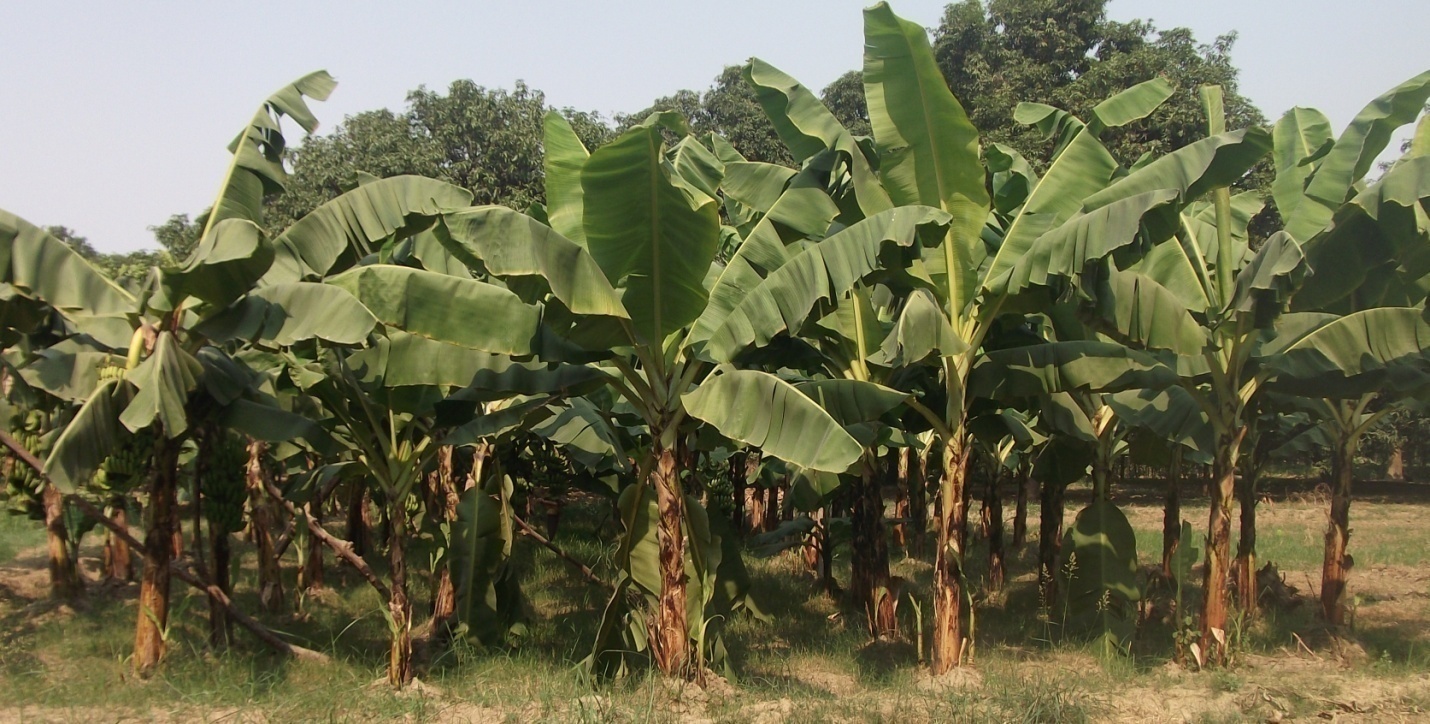 View of Banana Field
View of Banana Field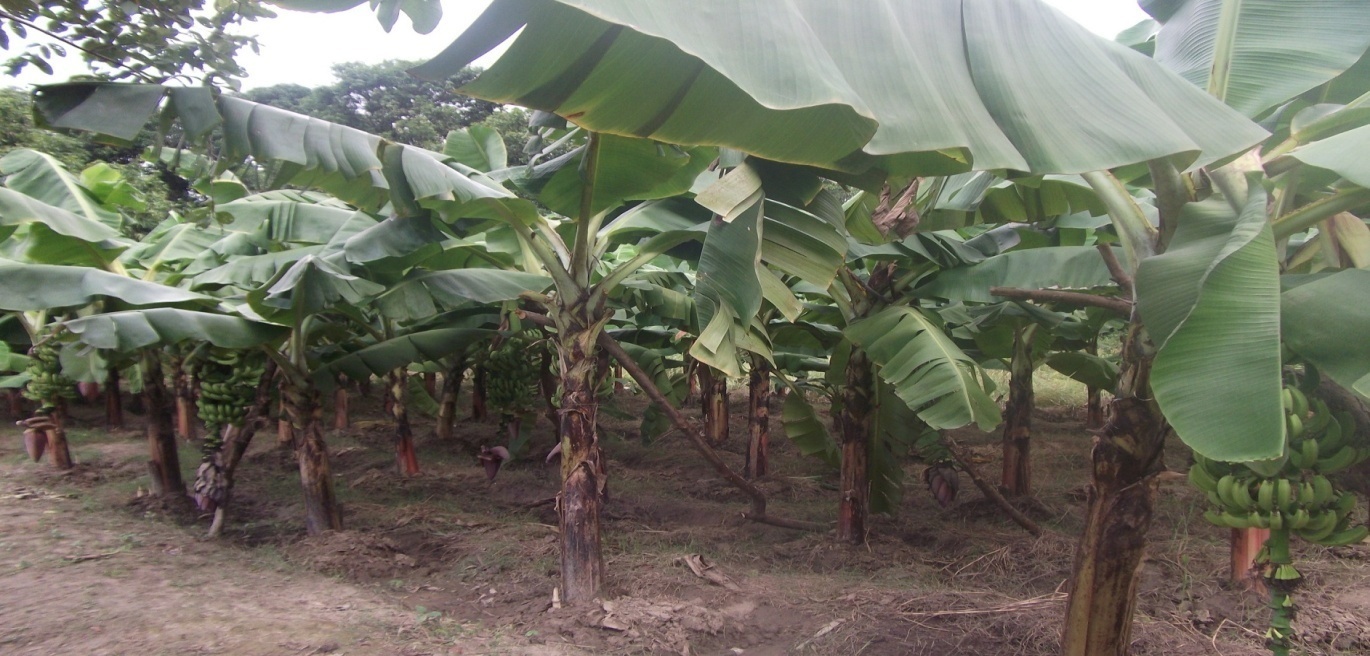 Banana plants in Bearing
Banana plants in Bearing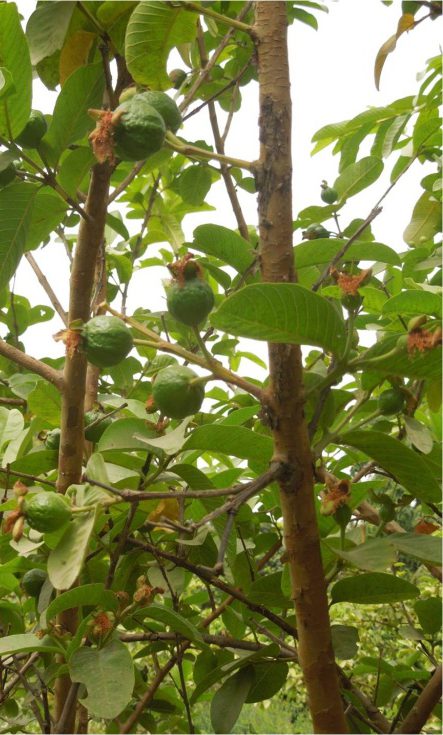 Guava in Bearing
Guava in Bearing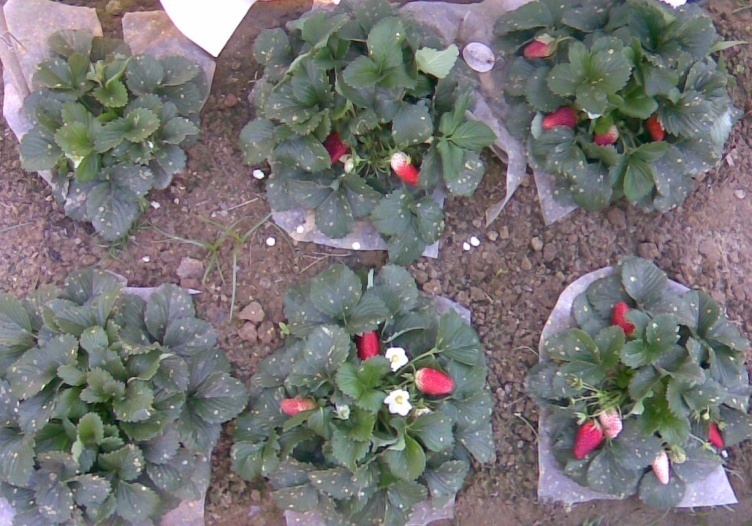 Black Polythene mulching in Strawberry cv Chandler
Black Polythene mulching in Strawberry cv Chandler Mango cv Amrapali in Bearing
Mango cv Amrapali in Bearing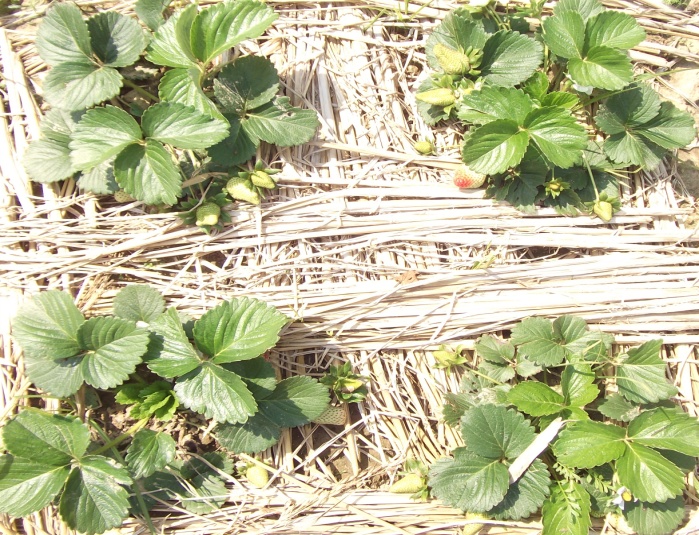 Organic mulching in Strawberry cv Chandler
Organic mulching in Strawberry cv Chandler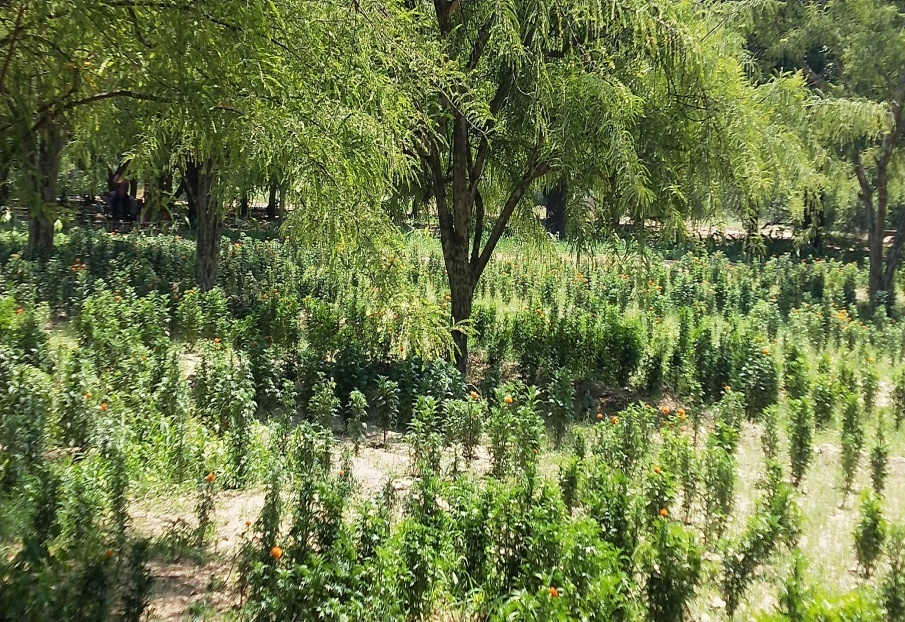 Marigold intercropping in Aonla cv NA-7 Orchard
Marigold intercropping in Aonla cv NA-7 Orchard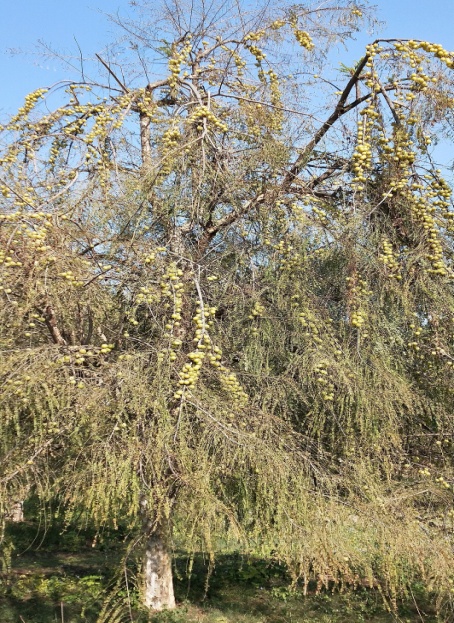 Aonla NA-7 in Bearing
Aonla NA-7 in Bearing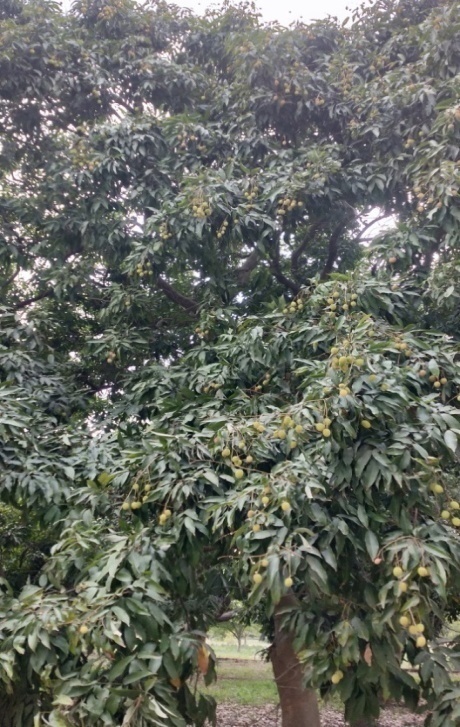 Litchi in Bearing
Litchi in Bearing Kinnow in Bearing
Kinnow in Bearing Banana cv G-9 Bunch
Banana cv G-9 Bunch